Overall assessment of the 2022-2023 hydrological year
The 2022-2023 recharge period was marked by a succession of rainfall-induced recharge episodes and dry spells. The levels then alternated between falling and rising trends. Rainfall during the autumn and winter was insufficient to recharge the aquifers, owing to the late growth of vegetation and the ground remaining very dry after each drought episode. Late winter rains (in March) and early spring rains (in April) led to recharge episodes, thus delaying the start of the depletion period in those areas with the highest rainfall. As a result of a very severe low-water period in 2022 for most of the aquifers and a sluggish recharge in 2022-2023, the situation of the aquifers was unsatisfactory at the end of the recharge period, except for the reactive to mixed aquifers on the Artois-Picardy coast, the Atlantic coast and in Corsica.
The 2023 depletion period gradually got underway between March and May. During the spring and summer of 2023, dry and wet spells continued to alternate. The rainfall was sufficient to infiltrate deep into the ground, generating recharge episodes and sustaining aquifer levels. The impact observed on aquifers depended on the total amount of rainfall and their respective responsiveness. As a result, the situation improved in areas which had rain and reactive aquifers while it stabilised in areas with less rainfall and inertial aquifers. However, the effect of precipitation on the aquifers diminished as the summer progressed. In the autumn, during the low-water period of 2023, the state of the aquifers varied greatly, depending on the local cumulative rainfall recorded between the autumn of 2022 and the summer of 2023 and on the respective cyclic fluctuations of the aquifers.
Situation at the start of the hydrological year
The lowest water levels in 2022 were recorded between mid-August 2022 and January 2023, sometimes 2 or even 3 months late. More specifically, the lowest water levels in the most reactive aquifers were recorded between mid-August and the end of November 2022. Many reactive to mixed aquifers in the east of the country reached low-water levels between mid-August and mid-September, with the first storms at the end of the summer halting the fall in levels: this was the case for the alluvial aquifers in the Alsace plain, Jurassic limestone aquifers in Berry, Côte-des-Bars and Jura, aquifers in the eastern Massif Central, alluvial aquifers in the Rhône, Saône and Alpine valleys, aquifers in Languedoc and alluvial aquifers in Corsica. The low-water period shifted to November 2022, thus several weeks late, for the reactive aquifers in the west: the basement aquifers from Brittany to the Vendée, the limestone aquifers from the Seuil du Poitou (Poitou threshold) to the Causses du Quercy and the basement aquifers in the Limousin. For the more inertial aquifers, the lowest water levels occurred between November 2022 and January 2023 for the Paris Basin aquifers and between November 2022 and mid-December 2022 for aquifers in the Rhône-Saône corridor.
The state of the aquifers during the low-water period in 2022, at the start of the 2022-2023 hydrological year, was unsatisfactory. Most levels were below normal. Rainfall deficits recorded in the 2021-2022 hydrological year and intense abstraction of groundwater in the spring and summer of 2022 led to severely low levels in most aquifers. The 2022 low-water period proved to be the most intense ever recorded for certain aquifers. For example, the springs in the karst limestone formations of the Vaucluse and the centre of the Var were starting to run dry. The aquifer in the Var's alluvial and tertiary formations became disconnected from surface water and no longer played its role of regulating the river's flow. Only a few aquifers have maintained levels comparable to their averages, in particular the alluvial aquifers of the Garonne, the Dordogne and their main tributaries.
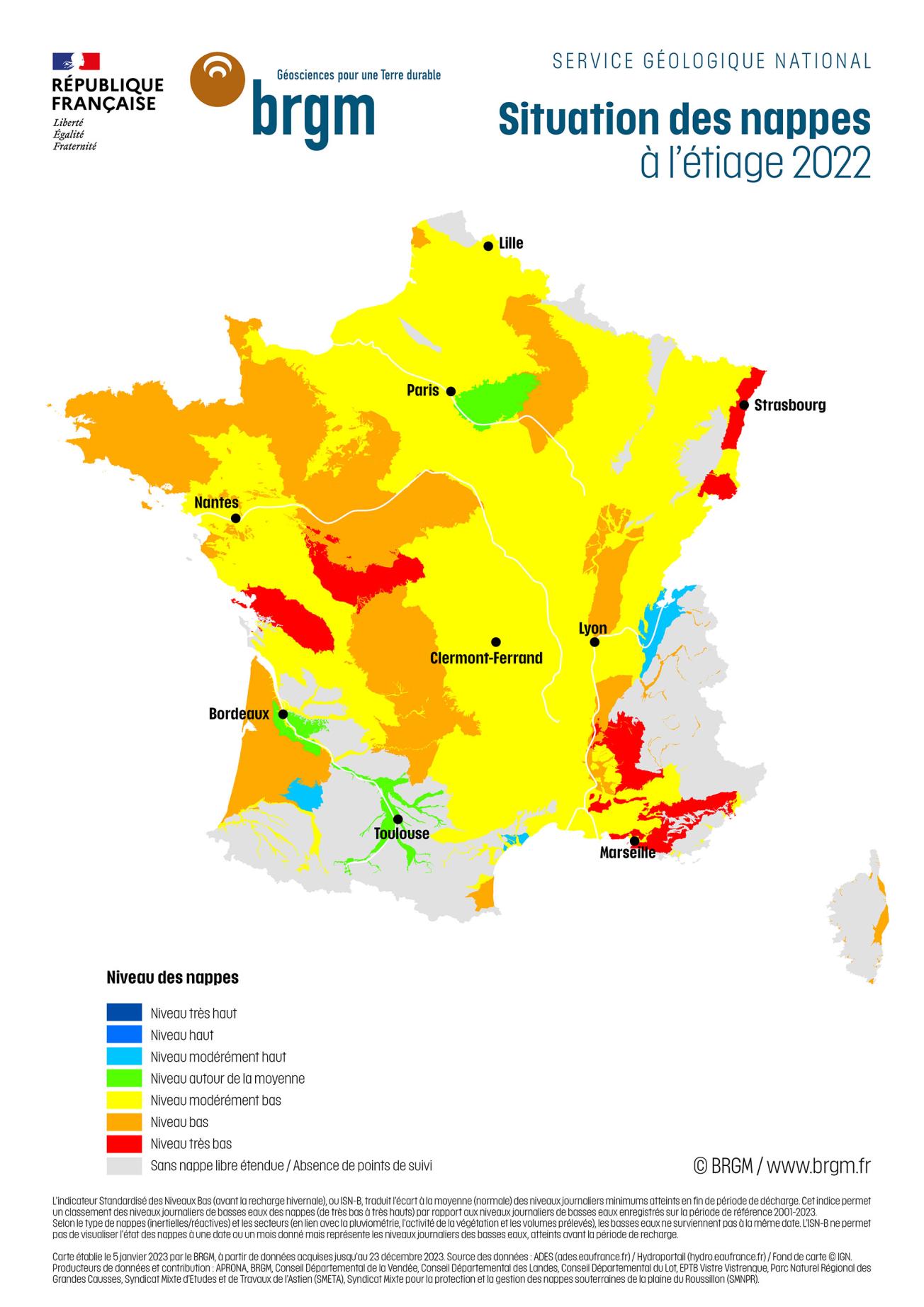
Groundwater situation during the low-water period in 2022
© BRGM
Analysis of the 2022-2023 recharge period
The aquifers are mainly recharged in autumn and winter because rainfall is generally higher, evaporation is low and vegetation is not very active, taking virtually no water from the soil. The rise in levels depends on the potential duration of recharge and the amount of rainfall during this period.
The impact of effective rainfall on aquifers (response time and variation in levels) depends on the thickness and nature of the ground through which it passes. The response time can be a few days for a reactive aquifer (alluvial deposits, sands, Cretaceous and Jurassic karst limestone formations, basement formations) and several weeks for an inertial aquifer (Cretaceous chalk, Eocene sand and limestone formations in Artois-Picardy and the Paris Basin, as well as Miocene, Plio-Quaternary and fluvio-glacial formations in the plains to the east of the Rhône and Saône rivers). The highest water levels, observed at the end of the recharge period, are generally recorded between March and May.
Evolution of aquifer recharging
The 2022-2023 recharge period was marked by a succession of recharge episodes and dry spells. The storms at the end of summer 2022, between mid-August and mid-September, may have led to small occasional recharges of reactive to mixed aquifers in the eastern half of France. During the autumn and early winter, the proportion of rain that infiltrated deep into the ground remained low. Recharge began with difficulty in many aquifers and then remained relatively insignificant. There are several reasons for this. Firstly, the rainfall from mid-September 2022 onwards served to moisten the very dry soils and was used by the vegetation. After that, the vegetation continued growing very late in the year, until the beginning of November 2022, due to mild temperatures. Finally, there was a lack of rainfall in late autumn and early winter. Recharging was underway at the end of December 2022 and in January 2023, but came to an abrupt halt in February 2023 when the rains stopped. Late winter rains and early spring rains (March-April) led to recharge episodes in those areas with the highest rainfall. These rains postponed the start of the depletion period and improved the situation, particularly for the reactive aquifers. Only the aquifers in the south-east did not benefit from this additional supply.
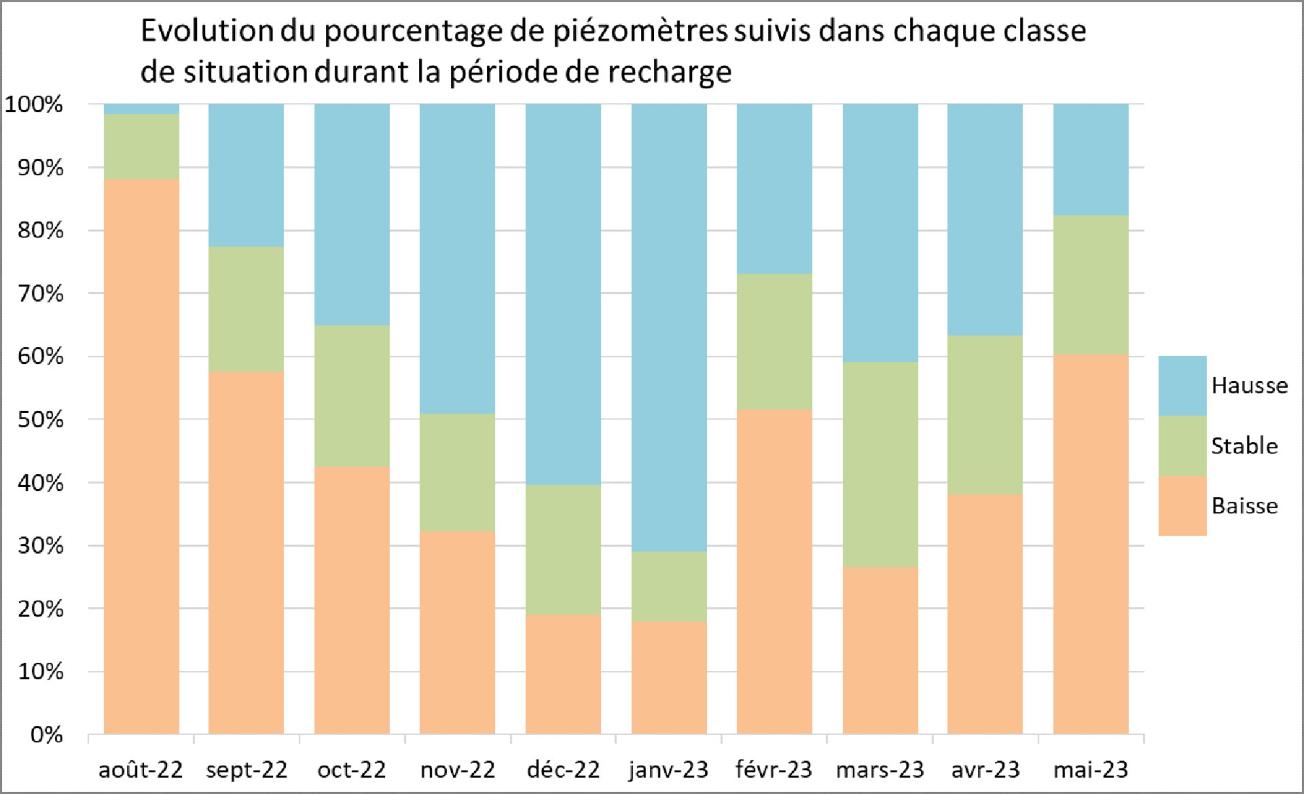
Piezometer trends observed between August 2022 and May 2023
© BRGM
Assessment of aquifer recharging
The autumn and winter of 2022-2023 were characterised by a period of low recharge. Recharge was insufficient at more than half the observation points. In particular, it was very low in the inertial to mixed aquifers of the central Paris Basin, the Saône and middle Rhône corridors (from the Dijon area to the north of Isère) and the Limagne plain. The Languedoc and Roussillon aquifers also suffered from inadequate recharge, due to insufficient rainfall. Some piezometers in the centre of the Paris Basin and on the Roussillon plain did not record any recharge episodes and levels remained lower or stable.
Surplus recharge was recorded in the aquifers along the coast from Flanders to the Basque country, as well as in Corsica. It should be noted that the overall recharge of the Seno-Turonian chalk aquifers in Normandy and Picardy is lower than normal, with surplus recharge on the coast and none at all in the east. Infiltrated rainfall in March and April 2023 made up for the previous months' deficits in the aquifers along the Atlantic seaboard and in Eastern France.
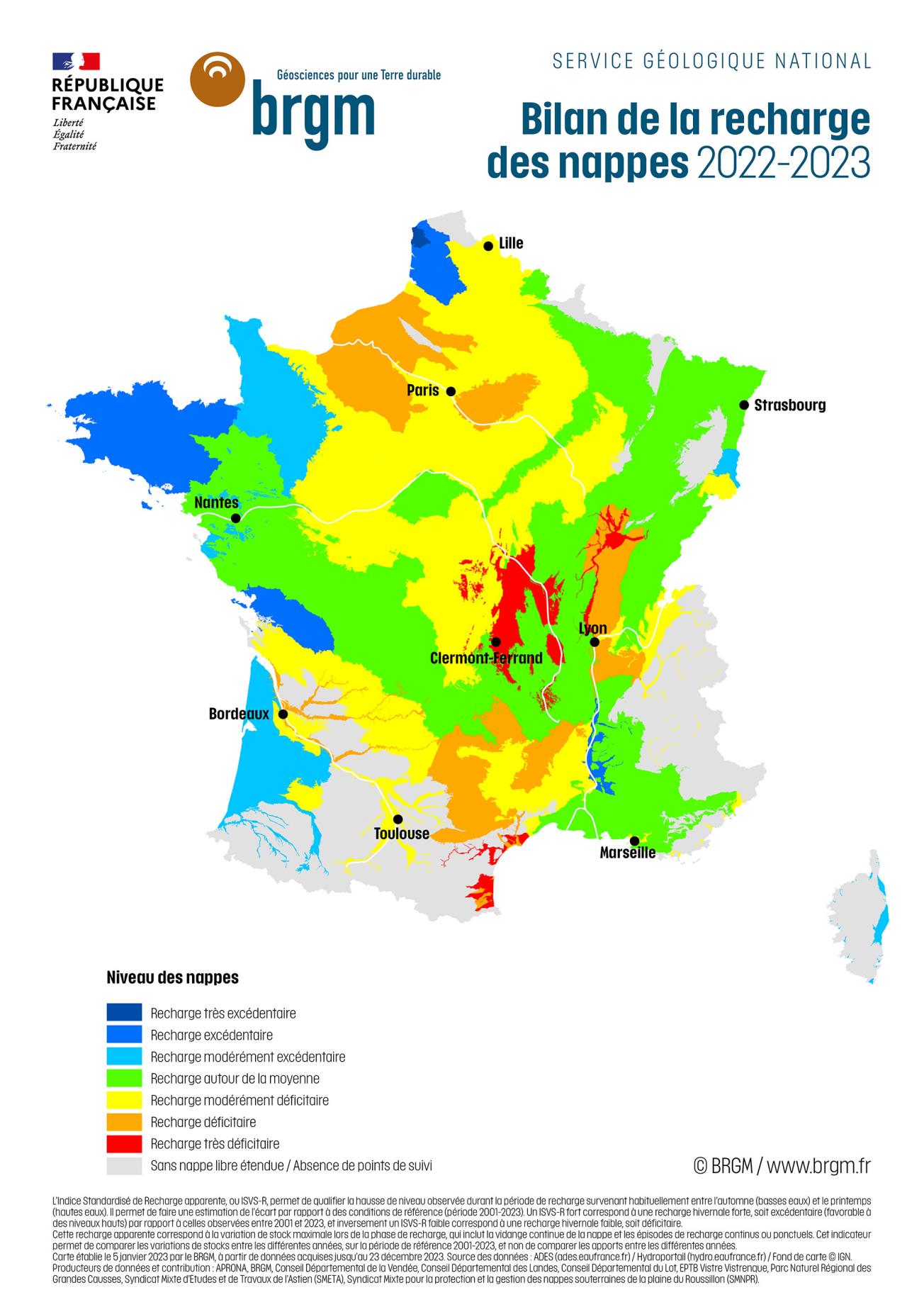
Assessment of groundwater recharge in 2022-2023
The Standardised Apparent Recharge Index, or ISVS-R (Indice Standardisé de Recharge apparente), is used to describe the rise in water level observed during the recharge period, which usually occurs between autumn (low water) and spring (high water). It provides an estimate of the deviation from reference conditions (2001-2023 period). A high ISVS-R corresponds to a high winter recharge, i.e. a surplus (favourable to high levels) compared with those observed between 2001 and 2023, and conversely a low ISVS-R corresponds to a low winter recharge, i.e. a deficit.
This apparent recharge corresponds to the maximum variation in an aquifer’s reserve during the recharge phase, which includes the continuous depletion of the water table and continuous or occasional recharge episodes. This indicator is used to compare changes in reserves between different years, over the reference period 2001-2023, and not to compare inflows between different years.
© BRGM
Groundwater situation at the end of the recharge period
The most significant inflow peak occurred in January 2023 in the reactive aquifers in the northern half and south-east of France. The end-of-winter inflows brought about the highest water levels in the south-west in March. With regard to the inertial aquifers, the highest water levels were recorded between April and May in the Paris Basin and between mid-January and the end of May in the Rhône-Saône corridor. It should be noted that these highest water levels did not always correspond to the end of the 2022-2023 recharge period, since rainfall in the spring may have generated new recharging.
The situation observed at the end of the 2022-2023 recharge period, when water levels were at their highest, depended on the situation during the 2022 low-water period, the 2022-2023 recharge balance and the cyclic fluctuations of the aquifers in question. Rainfall during the recharge period was far from enough to offset the deficits accumulated during the 2021-2022 hydrological year and bring about a lasting improvement in the state of the aquifers. As a result, more than three-quarters of aquifer highest-level readings for 2023 were below normal, with many areas showing low to very low levels.
Reactive aquifers, which have an annual cycle, are sensitive to infiltrated rainfall, due to rapid flow within the subsurface. Sectors that had benefited from several episodes of surplus recharge had levels comparable to ‘above normal’ at the end of the recharge period. These were mainly the reactive to mixed aquifers on the Artois-Picardy coast, the Atlantic seaboard and in Corsica. The low recharge had a major impact on the other reactive aquifers, whose levels remained below normal. These levels reached worryingly low levels in the Limagne and Mediterranean coastal aquifers.
Inertial aquifers, which are cyclical over several years, are highly resistant to the lack of rainfall. They were hardly affected by the 2022-2023 recharge deficit and their condition remained stable or deteriorated by one class between low water levels in 2022 and high-water levels in 2023. The inertial aquifers of the Paris Basin and the Rhône-Saône corridor recorded moderately low to low 2023 high-water levels. Levels in the Plio-Quaternary and Miocene gravel aquifers in Sundgau (southern Alsace), the Dijon area, Bresse and Dombes were very low and of more concern. Only the aquifer in the Savoyard foothills showed satisfactory levels, comparable to normal, at the end of the recharge period.
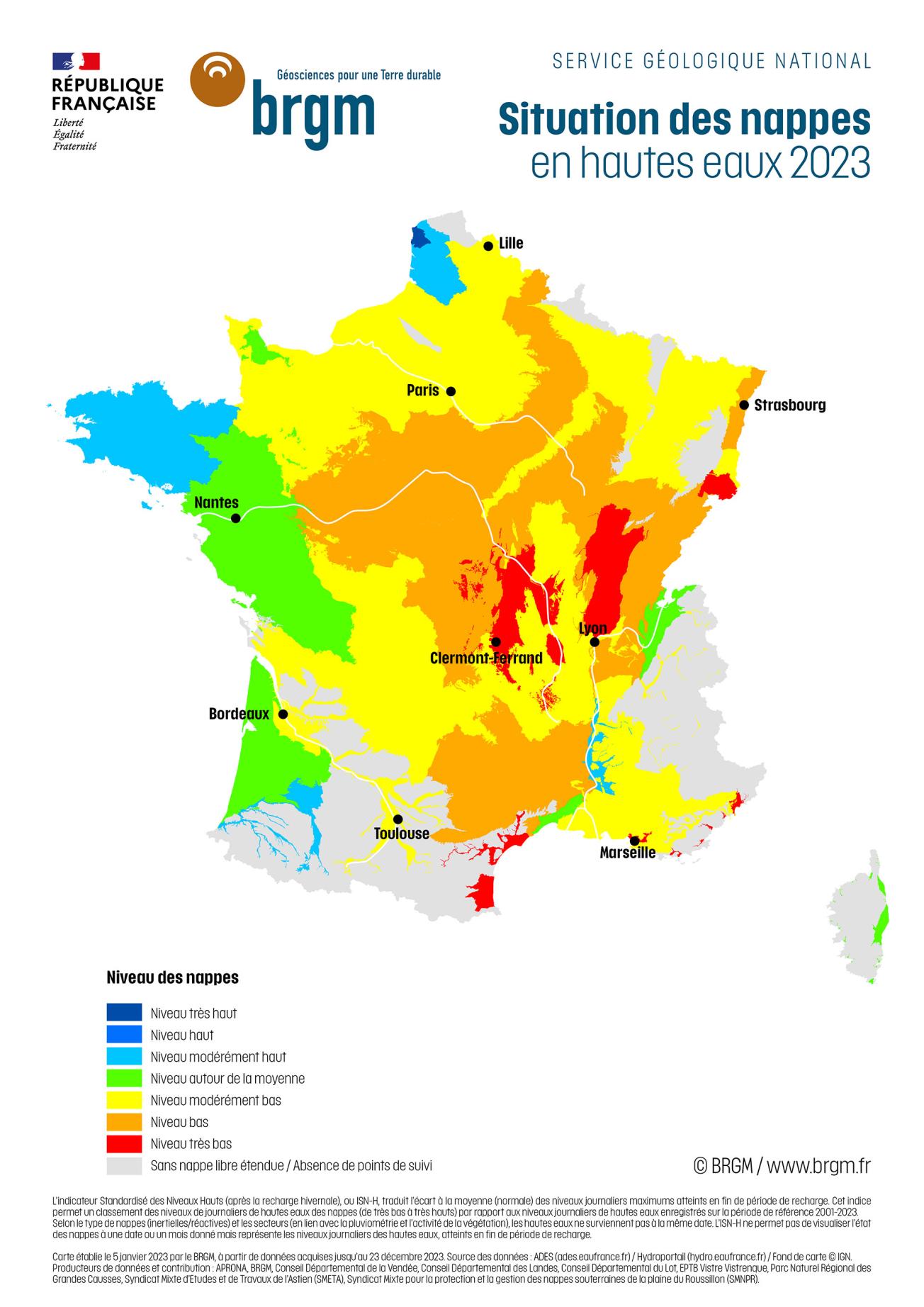
Groundwater high-water levels in 2023
The Standardised Indicator of High Levels (before winter recharge), or ISN-H (Indicateur Standardisé des Niveaux Hauts), reflects the standardized deviation from the mean (normal distribution) of the maximum daily levels reached at the end of the discharge period. This index is used to rank the daily high-water levels of aquifers (from very low to very high) in relation to the daily high-water levels recorded over the reference period 2001-2023.
According to the type of aquifer (inertial/reactive) and the sector (depending on rainfall, vegetation activity and volumes abstracted), the high-water levels do not occur on the same date. The ISN-H does not show the state of the aquifer for a given date or month, but represents the daily high-water levels reached before the recharge period begins.
© BRGM
Analysis of the 2023 low-water period
Generally speaking, the summer drop in levels is linked to low rainfall, high evapotranspiration and/or vegetation activity, as well as greater demands on groundwater in certain areas (pumping). Generally, from mid-spring through to autumn, rainwater seeping into the soil is usually taken up by vegetation. In this case, drought or rainfall have little effect on aquifer levels. An improved groundwater situation with higher aquifer levels will require significant rainfall, damp soil and vegetation that is more or less dormant. Abundant rainfall can only have an observable effect on reactive aquifers, resulting in a slowdown in groundwater discharge or even an increase, often temporary, in levels. These occasional inflows have a beneficial effect, as they postpone the start of the depletion period until the spring and sustain aquifer levels in summer. During the discharge period, the fall in levels can be greatly accelerated in areas where there is heavy demand (abstraction) on groundwater resources.
At the end of the discharge period, the aquifers reach their lowest level of the year, during the ‘low-water period’. These low-water levels are generally observed in October and November. But they may occur earlier in reactive aquifers, with end-of-summer storms towards the end of August or during September, marking the start of recharging.
Evolution of aquifer depletion
During the spring and summer of 2023, there were alternating wet periods, which could lead to recharge episodes, and dry periods, during which depletion occurred. There was enough occasional rainfall to generate recharging and sustain aquifer levels. However, the effect of precipitation on the aquifers diminished as the summer progressed. As vegetation began growing again and temperatures rose, the rainfall that seeped into the soil first moistened it and was taken up by the vegetation. The rainfall was therefore only beneficial for aquifers in areas that had enough rain to meet their needs and ensure that the rain infiltrated deep into the ground.
In the case of reactive to mixed aquifers, their trends and situation changed during the spring and summer of 2023, depending on the recharge episodes and depletion periods. At the beginning of spring, water levels were rising and the situation improved considerably in aquifers in the northern third of the country (Massif Armoricain, the Channel coast and Grand-Est), thanks to rainfall in March and especially April. In the southern third of the country, the rains in May moistened the soil and watered the vegetation, which enabled the June rains to infiltrate deep into the subsurface. However, their impact on aquifers varied, depending on local rainfall totals. In July and August, precipitation over the northern third of France resulted in stable or rising water levels during the month of August. This recharge episode remained limited, however, but helped to sustain aquifer levels. In addition, the rains enabled irrigation to be reduced to a greater or lesser extent, thus easing the pressure on groundwater resources.
The levels of the inertial aquifers continued to fall throughout the summer of 2023 and the state of the aquifers deteriorated very slowly. The spring and summer rains had little effect. This is normal, as these aquifers are not very sensitive to meteorological events during the summer. However, for the inertial aquifers of the Paris Basin and Artois, although the abundant rainfall in July and August was insufficient to reverse the trend, it did significantly slow their depletion.
On the Mediterranean rim, the rainfall which had infiltrated deep into the ground during the spring and summer of 2023 was insufficient to make up for the deficits accumulated since the beginning of 2022. The heavy rainfall in May and June did little for the aquifers. The rainfall was unevenly distributed and fell during sometimes violent storms, which were not conducive to infiltration into the subsurface. In addition, high temperatures encouraged evapotranspiration and increased plant water requirements. However, these rains did allow some inflow peaks to have an impact and they did improve the situation for the Provence aquifers. Several aquifers remained under stress, with persistent low to very low levels throughout the summer, namely aquifers on the Roussillon plain, aquifers on the Languedoc coast and on the Côte d'Azur. In the Roussillon aquifers, restrictions on the use of groundwater prevented a very worrying situation from deteriorating further.
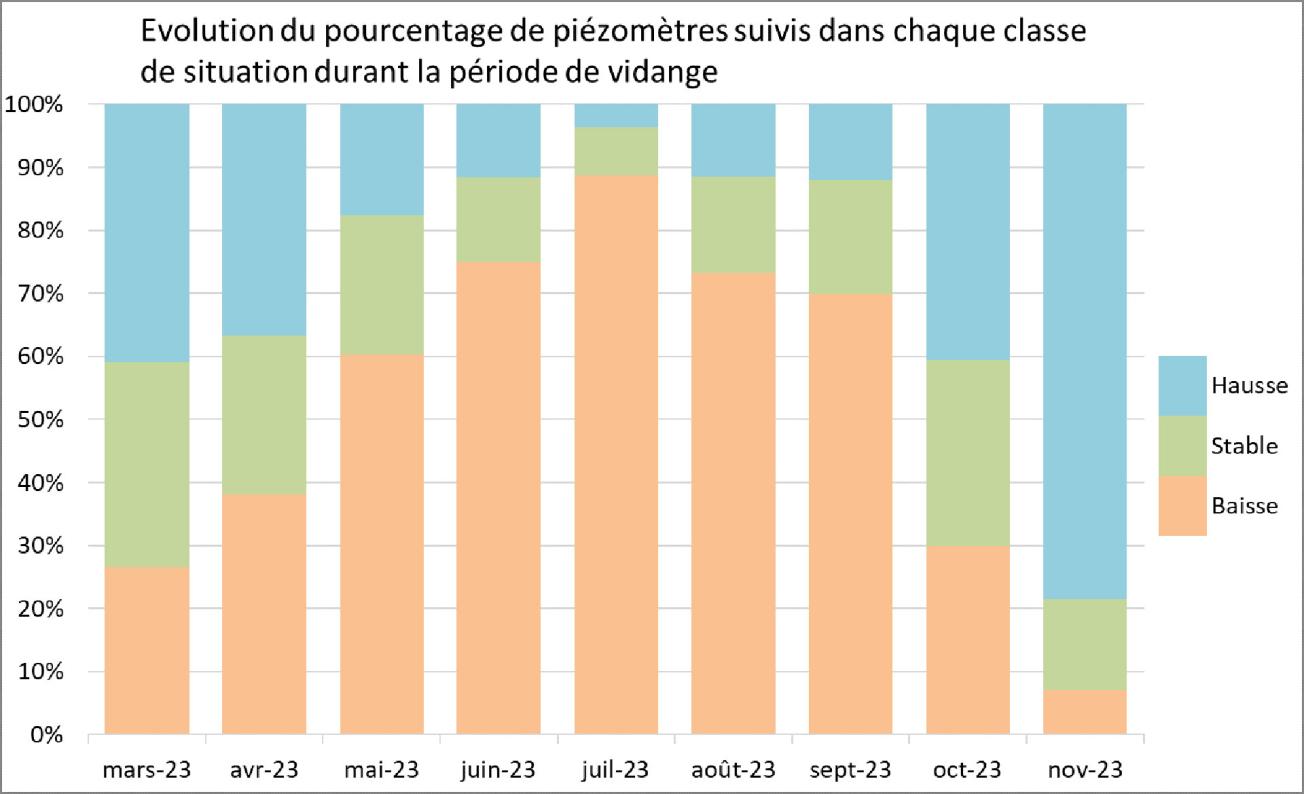
Piezometer trends observed between March and November 2023
© BRGM
Groundwater situation at the end of the depletion period
The 2023 low-water levels (lowest water level) were observed to be a little later than usual, during the second half of October, for the reactive and mixed aquifers, and spread out between the end of October and mid-December for the inertial aquifers. The recharge period began rapidly and at the same time in virtually all the aquifers. This was due to heavy rainfall from mid-October and into November over almost the entire country. There were exceptions in a few sectors: low-water levels occurred between the end of August and mid-September in the extreme south-west, during August on the Alsace plain water table and in December for the Bas-Rhône aquifers. Finally, the aquifers of the Roussillon plain and the Corbières massif were still being depleted in January 2024.
The depletion period is usually characterised by a gradual deterioration in the state of the aquifers. However, the 2023 discharging period was atypical, with several recharge episodes interspersed. These recharge episodes improved or sustained the general state of the reactive aquifers, as well as that of inertial aquifers in a few areas. The state of the aquifers during the low-water period in 2023 was very heterogeneous, depending on the local rainfall totals recorded between autumn 2022 and summer 2023 and on the cyclic fluctuations of the aquifers in question.
With regard to inertial aquifers, there was little change in levels between the high-water and low-water periods in 2023. They generally remained below normal, from moderately low to low. The situation was more unfavourable in the aquifers of the Plio-Quaternary and Miocene formations of Sundgau (southern Alsace) and the Dijon, Bresse and Dombes areas. Only the aquifers in the Artois area and Savoyard foothills had levels above normal. These sectors benefited from several recharge episodes during the summer.
The situation also remained variable as regards the reactive aquifers. The levels were satisfactory, from moderately low to moderately high, in the west, in the Champagne region and from the Artois area to Nouvelle Aquitaine. This was due to several recharge episodes during the spring and summer, which helped to improve or sustain the state of the aquifers in those areas. Over the rest of the country, the levels in reactive aquifers remained moderately low to low. The situation remained poor around the Mediterranean coast. The 2023 low-water period was particularly intense in the aquifers of the Roussillon plain, the limestone formations of the Corbières massif, and in the alluvial aquifers of the Hérault and Orb rivers and in the Côte d'Azur. The accumulated rainfall infiltrated during the 2022-2023 hydrological year was far from enough to compensate for the deficits accumulated since the previous hydrological year.
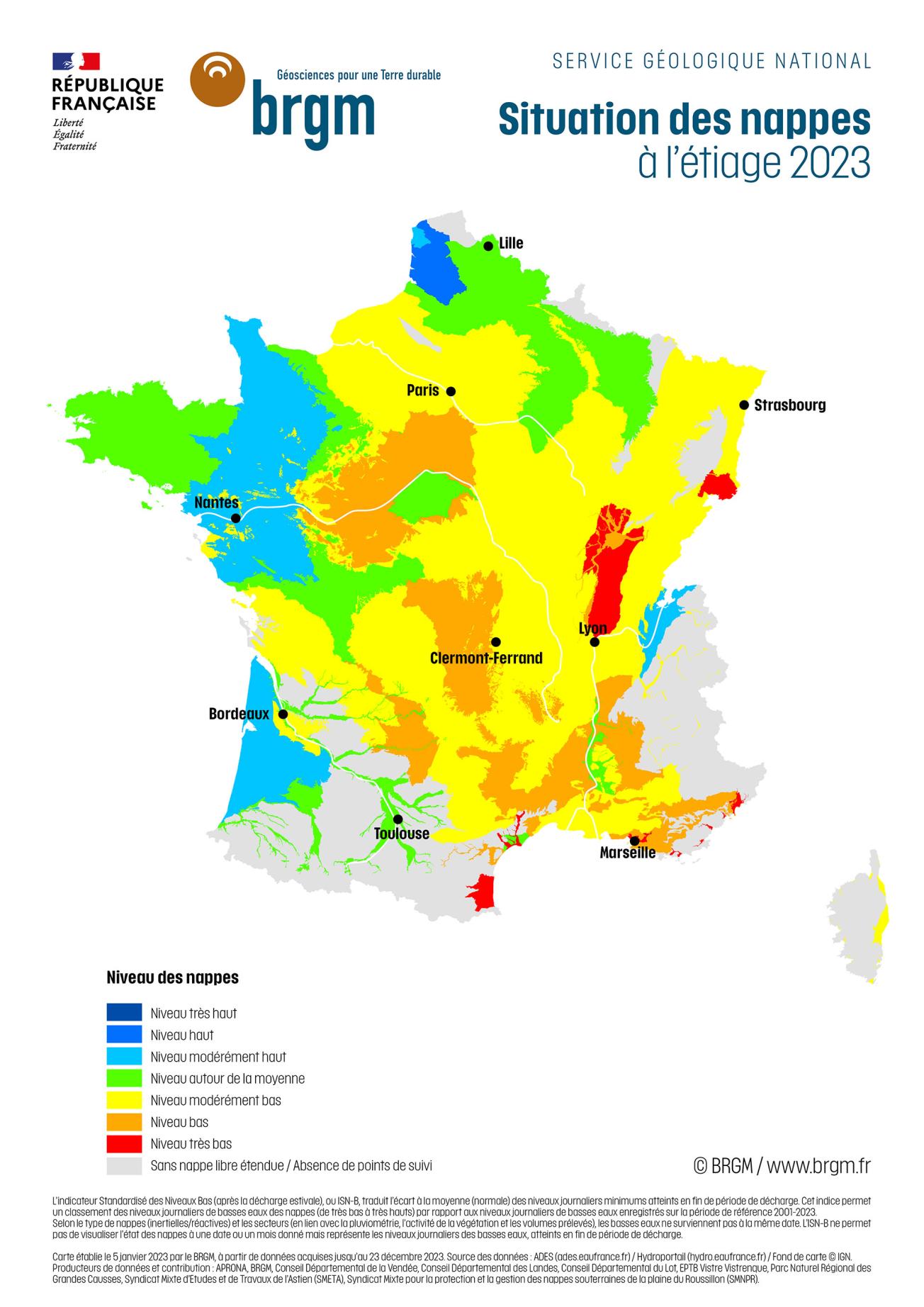
Groundwater situation during the low-water period in 2023
The Standardised Indicator of Low Levels (after the summer discharge), or ISN-B, reflects the standardized deviation from the mean (normal distribution) of the minimum daily levels reached at the end of the discharge period. This index is used to rank the daily low-water levels of aquifers (from very low to very high) in relation to the daily low-water levels recorded over the reference period 2001-2023.
Depending on the type of aquifer (inertial/reactive) and the sector (depending on rainfall, vegetation activity and volumes abstracted), the low-water levels do not occur on the same date. The ISN-B does not show the state of the aquifer for a given date or month, but represents the daily low-water levels reached before the discharge period begins.
© BRGM

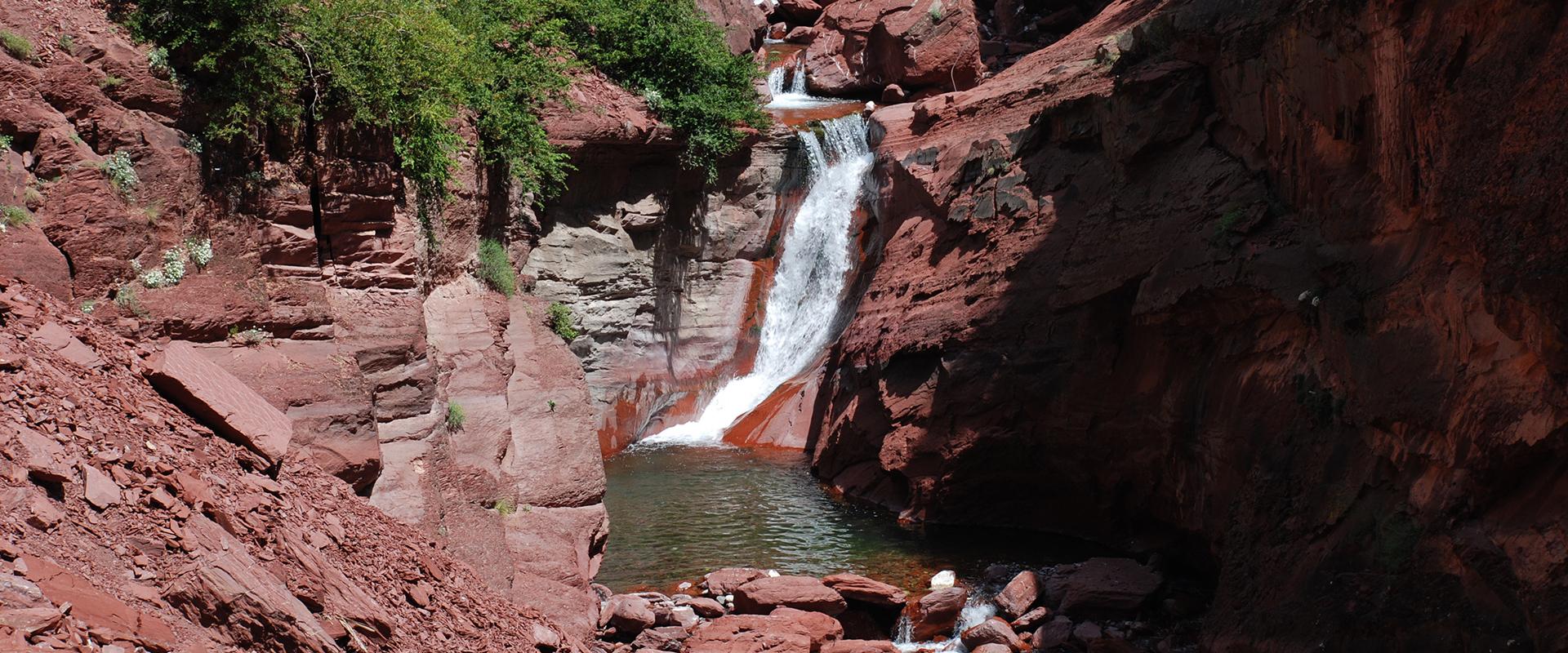




The Standardised Indicator of Low Levels (before winter recharge), or ISN-B (Indicateur Standardisé des Niveaux Bas), reflects the standardized deviation from the mean (normal) of the minimum daily levels reached at the end of the discharge period. This index is used to rank the daily low-water levels of aquifers (from very low to very high) in relation to the daily low-water levels recorded over the reference period 2001-2023.
Depending on the type of aquifer (inertial/reactive) and the sector (rainfall, vegetation activity and volumes abstracted), the low-water levels do not occur on the same date. The ISN-B does not show the state of the aquifer for a given date or month, but represents the daily low-water levels reached before the recharge period begins.
Map drawn up by BRGM on 5 January 2023, based on data acquired up to 23 December 2023. Data source: ADES (ades.eaufrance.fr) / Hydroportail (hydro.eaufrance.fr) / Background map © IGN.
Data producers and contributors: APRONA, BRGM, Conseil Départemental de la Vendée, Conseil Départemental des Landes, Conseil Départemental du Lot, EPTB Vistre Vistrenque, Parc Naturel Régional des Grandes Causses, SMETA (Syndicat Mixte d'Etudes et de Travaux de l'Astien), SMNPR (Syndicat Mixte pour la protection et la gestion des nappes souterraines de la plaine du Roussillon).